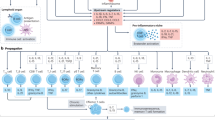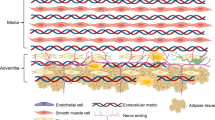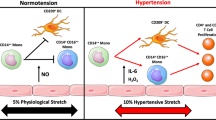Abstract
Understanding the mechanism by which chronic high blood pressure induces vascular disease is of fundamental importance for prevention of the adverse consequences of hypertension. Clinical and population studies have consistently found increased circulating levels of interleukin 18 (IL-18) in patients with hypertension. Although obesity, and possibly age, is a determinant of plasma IL-18 levels, the relationship of IL-18 to hypertension seems to be independent of these factors. Experimental evidence indicates that the expression of IL-18 and/or its receptor can be induced by catecholamines or angiotensin, two factors that are involved in the pathophysiology of hypertension. Elevated circulating IL-18 levels are associated with vascular changes in the carotid artery, including increased carotid intima–media thickness, which, in turn, is a predictor of cardiovascular events in patients with established coronary disease. IL-18, either directly or through oxidative stress pathways and matrix metalloproteins, can alter endothelial function or induce vascular smooth muscle cell migration and/or proliferation to produce the vascular changes that occur with hypertension. This Review examines the data on IL-18 and hypertensive vascular disease, and explores the potential cellular and molecular mechanisms that might connect hypertension to vascular disease.
Key Points
-
The majority of data indicate that individuals with hypertension have higher levels of circulating IL-18 than individuals with normal blood pressure
-
Although IL-18 is associated with obesity, neither age nor obesity seems to explain the relationship between IL-18 and hypertension
-
IL-18 enhances the capacity of other factors to increase reactive oxygen species production from NADPH oxidase
-
Angiotensin II enhances the expression of IL-18-induced inflammatory genes in vascular smooth muscle by increasing IL-18Rα expression
-
IL-18 increases expression of matrix metalloproteinases, which alter vascular structure
-
IL-18 might be involved in the pathways that produce hypertension-induced vascular disease
-
Catecholamines increase IL-18 production, which might account for vascular changes induced by catecholamines
This is a preview of subscription content, access via your institution
Access options
Subscribe to this journal
Receive 12 print issues and online access
$209.00 per year
only $17.42 per issue
Buy this article
- Purchase on Springer Link
- Instant access to full article PDF
Prices may be subject to local taxes which are calculated during checkout

Similar content being viewed by others
References
Edwards KM et al. (2007) The potential anti-inflammatory benefits of improving physical fitness in hypertension. J Hypertens 25: 1533–1542
Vaziri ND and Rodríguez-Iturbe B (2006) Mechanisms of disease: oxidative stress and inflammation in the pathogenesis of hypertension. Nat Clin Pract Nephrol 2: 582–593
Streja D et al. (2003) Associations between inflammatory markers, traditional risk factors, and complications in patients with type 2 diabetes mellitus. J Diabetes Complications 17: 120–127
Jenny NS et al. (2007) Inflammation biomarkers and near-term death in older men. Am J Epidemiol 165: 684–695
Ghayur T et al. (1997) Caspase-1 processes IFN-gamma-inducing factor and regulates LPS-induced IFN-gamma production. Nature 386: 619–623
Akita K et al. (1997) Involvement of caspase-1 and caspase-3 in the production and processing of mature human interleukin 18 in monocytic THP.1 cells. J Biol Chem 272: 26595–26603
Torigoe K et al. (1997) Purification and characterization of the human interleukin-18 receptor. J Biol Chem 272: 25737–25742
Kato Z et al. (2003) The structure and binding mode of interleukin-18. Nat Struct Biol 10: 966–971
Nakanishi K et al. (2001) Interleukin-18 regulates both Th1 and Th2 responses. Ann Rev Immunol 19: 423–474
Gracie JA et al. (2003) Interleukin-18. J Leukoc Biol 73: 213–224
Gerdes N et al. (2002) Expression of interleukin (IL)-18 and functional IL-18 receptor on human vascular endothelial cells, smooth muscle cells, and macrophages: implications for atherogenesis. J Exp Med 195: 245–257
Packard RR and Libby P (2008) Inflammation in atherosclerosis: from vascular biology to biomarker discovery and risk prediction. Clin Chem 54: 24–38
Thompson SR and Humphries SE (2007) Interleukin-18 genetics and inflammatory disease susceptibility. Genes Immun 8: 91–99
Chandrasekar B et al. (2006) Interleukin-18-induced human coronary artery smooth muscle cell migration is dependent on NF-kappaB- and AP-1-mediated matrix metalloproteinase-9 expression and is inhibited by atorvastatin. J Biol Chem 281: 15099–15109
Li SL et al. (2006) Enhanced proatherogenic responses in macrophages and vascular smooth muscle cells derived from diabetic db/db mice. Diabetes 55: 2611–2619
Tiret L et al. (2005) Genetic analysis of the interleukin-18 system highlights the role of the interleukin-18 gene in cardiovascular disease. Circulation 112: 643–650
Blankenberg S et al. (2006) Haplotypes of the caspase-1 gene, plasma caspase-1 levels, and cardiovascular risk. Circ Res 99: 102–108
Hulthe J. et al. (2006) Plasma interleukin (IL)-18 concentrations is elevated in patients with previous myocardial infarction and related to severity of coronary atherosclerosis independently of C-reactive protein and IL-6. Atherosclerosis 188: 450–454
Chapman CM et al. (2006) Interleukin-18 levels are not associated with subclinical carotid atherosclerosis in a community population. The Perth Carotid Ultrasound Disease Assessment Study (CUDAS). Atherosclerosis 189: 414–419
Vilarrasa N et al. (2006) IL-18: relationship with anthropometry, body composition parameters, leptin and arterial hypertension. Horm Metab Res 38: 507–512
Yamagami H et al. (2005) Associations of serum IL-18 levels with carotid intima–media thickness. Arterioscler Thromb Vasc Biol 25: 1458–1462
Blankenberg S et al. (2003) Interleukin-18 and the risk of coronary heart disease in European men: the Prospective Epidemiological Study of Myocardial Infarction (PRIME). Circulation 108: 2453–2459
Evans J et al. (2007) The association of interleukin-18 genotype and serum levels with metabolic risk factors for cardiovascular disease. Eur J Endocrinol 157: 633–640
Hung J et al. (2008) C-reactive protein and interleukin-18 levels in relation to coronary heart disease: prospective cohort study from Busselton Western Australia. Heart Lung Circ 17: 90–95
Thorand B et al. (2005) Elevated levels of interleukin-18 predict the development of type 2 diabetes: results from the MONICA/KORA Augsburg Study, 1984–2002. Diabetes 54: 2932–2938
Hung J et al. (2005) Elevated interleukin-18 levels are associated with the metabolic syndrome independent of obesity and insulin resistance. Arterioscler Thromb Vasc Biol 25: 1268–1273
Zirlik A et al. (2007) Interleukin-18, the metabolic syndrome, and subclinical atherosclerosis: results from the Dallas Heart Study. Arterioscler Thrombosis Vasc Biol 27: 2043–2049
Tso TK et al. (2006) Relationship of plasma interleukin-18 concentrations to traditional and non-traditional cardiovascular risk factors in patients with systemic lupus erythematosus. Rheumatology (Oxford) 45: 1148–1153
Rabkin SW (2007) Epicardial fat: properties, function and relationship to obesity. Obes Rev 8: 253–261
Rabkin SW et al. (1977) Relation of body weight to development of ischemic heart disease in a cohort of young North American men after a 26 year observation period: the Manitoba Study. Am J Cardiol 39: 452–458
Nevill AM et al. (2006) Relationship between adiposity and body size reveals limitations of BMI. Am J Phys Anthropol 129: 151–156
Cuspidi C et al. (2002) Role of echocardiography and carotid ultrasonography in stratifying risk in patients with essential hypertension: the Assessment of Prognostic Risk Observational Survey. J Hypertens 20: 1307–1314
Lorenz MW et al. (2007) Prediction of clinical cardiovascular events with carotid intima–media thickness: a systematic review and meta-analysis. Circulation 115: 459–467
Korshunov VA et al. (2006) Interleukin-18 and macrophage migration inhibitory factor are associated with increased carotid intima–media thickening. Arterioscler, Thromb Vasc Biol 26: 295–300
Aso Y et al. (2003) Relationships of plasma interleukin-18 concentrations to hyperhomocysteinemia and carotid intimal–media wall thickness in patients with type 2 diabetes. Diabetes Care 26: 2622–2627
Bis JC et al. (2008) Variation in inflammation-related genes and risk of incident nonfatal myocardial infarction or ischemic stroke. Atherosclerosis 198: 166–173
Chandrasekar B et al. (2004) Activation of intrinsic and extrinsic proapoptotic signaling pathways in interleukin-18-mediated human cardiac endothelial cell death. J Biol Chem 279: 20221–20233
Chandrasekar B et al. (2006) Interleukin-18 induces human cardiac endothelial cell death via a novel signaling pathway involving NF-kappaB-dependent PTEN activation. Biochem Biophys Res Commun 339: 956–963
Sahar S et al. (2005) Angiotensin II enhances interleukin-18 mediated inflammatory gene expression in vascular smooth muscle cells: a novel cross-talk in the pathogenesis of atherosclerosis. Circ Res 96: 1064–1071
Chandrasekar B et al. (2005) The pro-atherogenic cytokine interleukin-18 induces CXCL16 expression in rat aortic smooth muscle cells via MyD88, interleukin-1 receptor-associated kinase, tumor necrosis factor receptor-associated factor 6, c-Src, phosphatidylinositol 3-kinase, Akt, c-Jun N-terminal kinase, and activator protein-1 signaling. J Biol Chem 280: 26263–26277
Yang H et al. (1989) Autoradiographic study of smooth muscle cell proliferation in spontaneously hypertensive rats. Clin Sci (Lond) 76: 475–478
Izzard AS et al. (2005) Small artery structure and hypertension: adaptive changes and target organ damage. J Hypertens 23: 247–250
Schwartz SM et al. (1986) Replication of smooth muscle cells in vascular disease. Circ Res 58: 427–444
Paravicini TM and Touyz RM (2006) Redox signaling in hypertension. Cardiovasc Res 71: 247–258
Williams HC and Griendling KK (2007) NADPH oxidase inhibitors: new antihypertensive agents? J Cardiovasc Pharmacol 50: 9–16
Clempus RE and Griendling KK (2006) Reactive oxygen species signaling in vascular smooth muscle cells. Cardiovasc Res 71: 216–225
Elbim C et al. (2005) Interleukin-18 primes the oxidative burst of neutrophils in response to formyl-peptides: role of cytochrome b558 translocation and N-formyl peptide receptor endocytosis. Clin Diagn Lab Immunol 12: 436–446
Wyman TH et al. (2002) Physiological levels of interleukin-18 stimulate multiple neutrophil functions through p38 MAP kinase activation. J Leukoc Biol 72: 401–409
Escobales N and Crespo MJ (2005) Oxidative-nitrosative stress in hypertension. Curr Vasc Pharmacol 3: 231–246
Doi T et al. (2008) Aldosterone induces interleukin-18 through endothelin-1, angiotensin II, Rho/Rho-kinase, and PPARs in cardiomyocytes. Am J Physiol Heart Circ Physiol 295: H1279–H1287
Brown MJ and Macquin I (1981) Is adrenaline the cause of essential hypertension? Lancet 2: 1079–1082
de Champlain J et al. (1989) The sympatho-adrenal tone and reactivity in human hypertension. Clin Exp Hypertens A 11(Suppl 1): 159–171
Rumantir MS et al. (2000) The 'adrenaline hypothesis' of hypertension revisited: evidence for adrenaline release from the heart of patients with essential hypertension. J Hypertens 18: 717–723
Chandrasekar B et al. (2004) Beta-adrenergic stimulation induces interleukin-18 expression via beta2-AR, PI3K, Akt, IKK, and NF-kappaB. Biochem Biophys Res Commun 319: 304–311
Ra HJ and Parks WC (2007) Control of matrix metalloproteinase catalytic activity. Matrix Biol 26: 587–596
Visse R and Nagase H (2003) Matrix metalloproteinases and tissue inhibitors of metalloproteinases: structure, function, and biochemistry. Circ Res 92: 827–839
Galis ZS and Khatri JJ (2002) Matrix metalloproteinases in vascular remodeling and atherogenesis: the good, the bad, and the ugly. Circ Res 90: 251–262
Yasmin et al. (2005) Matrix metalloproteinase-9 (MMP-9), MMP-2, and serum elastase activity are associated with systolic hypertension and arterial stiffness. Arterioscler Thromb Vasc Biol 25: 372–378
Derosa G et al. (2006) Matrix metalloproteinase-2, -9, and tissue inhibitor of metalloproteinase-1 in patients with hypertension. Endothelium 13: 227–231
Tayebjee MH et al. (2005) Circulating matrix metalloproteinase-9 and tissue inhibitors of metalloproteinases-1 and -2 levels in gestational hypertension. Am J Hypertens 18: 325–329
Zervoudaki A et al. (2003) Plasma levels of active extracellular matrix metalloproteinases 2 and 9 in patients with essential hypertension before and after antihypertensive treatment. J Hum Hypertens 17: 119–124
Li-Saw-Hee FL et al. (2000) Matrix metalloproteinase-9 and tissue inhibitor metalloproteinase-1 levels in essential hypertension. Relationship to left ventricular mass and anti-hypertensive therapy. Int J Cardiol 75: 43–47
Ergul A et al. (2004) Downregulation of vascular matrix metalloproteinase inducer and activator proteins in hypertensive patients. Am J Hypertens 17: 775–782
Zhou S et al. (2007) Matrix metalloproteinase-9 polymorphism contributes to blood pressure and arterial stiffness in essential hypertension. J Hum Hypertens 21: 861–867
Tayebjee MH et al. (2004) Matrix metalloproteinase-9 and tissue inhibitor of metalloproteinase-1 and -2 in type 2 diabetes: effect of 1 year's cardiovascular risk reduction therapy. Diabetes Care 27: 2049–2051
Chew DK et al. (2004) Matrix metalloproteinase-specific inhibition of Ca2+ entry mechanisms of vascular contraction. J Vasc Surg 40: 1001–1010
Novak A and Dedhar S (1999) Signaling through beta-catenin and Lef/Tcf. Cell Mol Life Sci 56: 523–537
Johnson C and Galis ZS (2004) Matrix metalloproteinase-2 and -9 differentially regulate smooth muscle cell migration and cell-mediated collagen organization. Arterioscler Thromb Vasc Biol 24: 54–60
Sinha I et al. (2006) The nitric oxide donor DETA-NONOate decreases matrix metalloproteinase-9 expression and activity in rat aortic smooth muscle and abdominal aortic explants. Ann Vasc Surg 20: 92–98
Minoguchi K et al. (2005) Increased carotid intima–media thickness and serum inflammatory markers in obstructive sleep apnea. Am J Respir Crit Care Med 172: 625–630
Author information
Authors and Affiliations
Ethics declarations
Competing interests
The author declares no competing financial interests.
Rights and permissions
About this article
Cite this article
Rabkin, S. The role of interleukin 18 in the pathogenesis of hypertension-induced vascular disease. Nat Rev Cardiol 6, 192–199 (2009). https://doi.org/10.1038/ncpcardio1453
Received:
Accepted:
Issue Date:
DOI: https://doi.org/10.1038/ncpcardio1453
This article is cited by
-
Lumbar spine intervertebral disc desiccation is associated with medical comorbidities linked to systemic inflammation
Archives of Orthopaedic and Trauma Surgery (2021)
-
Expression of mRNA and protein of IL-18 and its receptor in human follicular granulosa cells
Journal of Endocrinological Investigation (2017)
-
Effects of transcutaneous electrical nerve stimulation (TENS) on arterial stiffness and blood pressure in resistant hypertensive individuals: study protocol for a randomized controlled trial
Trials (2016)
-
Circulating levels of IL-18 are significantly influenced by the IL-18 +183 A/G polymorphism in coronary artery disease patients with diabetes type 2 and the metabolic syndrome: an Observational Study
Cardiovascular Diabetology (2011)
-
Is there an association between non-functioning adrenal adenoma and endothelial dysfunction?
Journal of Endocrinological Investigation (2011)



